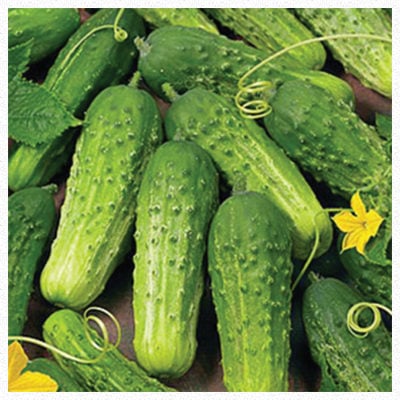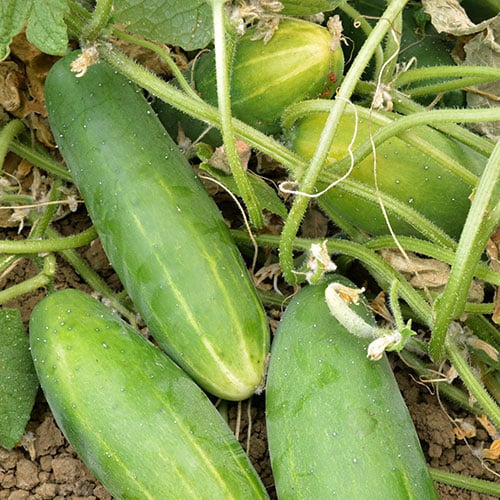
Learning Download: How to Grow Cucumbers
From Seed to Harvest: A guide to growing cucumbers.
Cucumbers can be grown for fresh eating, pickling and more. They range in flavor, colors, shapes and sizes. Some cucumbers are known as lemon cucumbers and are yellow. Cucumbers can grow in circles, elongated spheres and more.
To plant:
Plant seeds directly in rows or hills two weeks after the last spring frost. Seeds can sprout within five days. If you started the cucumbers inside, transplant seedlings after they are 3 weeks old and after the last spring frost. Space the cucumber rows or hills 6 feet apart, as cucumbers can take up lots of space.
Water prior to placing the seeds, and plant the seeds 1/2-inch-deep and 6 inches apart. Once seedlings grow three leaves, thin them to 12 inches apart. For gardeners who rotate their crops, plant cucumbers in the same place where Cole crops grew the year before.
To grow:
Cucumbers like full sun and well-drained soil with a pH of 6.0 to 6.5. Water 1 inch per week. Water consistently, because inconsistent watering watering can create misshapen cucumbers. To maximize the amount of cucumbers and decrease leaves, use a trellis or tomato cage to grow the cucumbers. To prevent pests, use row covers with your cucumbers. Use traps to prevent cucumber beetles, or plant borage nearby.
Cucumbers produce both male and female blooms, which are required for fruit growth. Male blooms drop off the plant, but female blooms will have the small swell at the base which turns into the cucumber.
To harvest:
Pick cucumbers often, as they can double in size quickly. To allow for the maximum harvest, pick cucumbers as soon as they are big enough. One plant can grow anywhere between 10 and 20 cucumbers. To pick the plant, use a knife or small shears to clip the stem just above the fruit. When a cucumber yellows at the bottom, it is overripe. Use cucumbers as soon as possible after harvesting.
What cucumbers crave:
When planting, mix compost with a little bit of organic fertilizer. During growth, use liquid fertilizer and apply directly to the soil near the stem. Granular fertilizer also can be used, but work it into the soil around the plant. Feed with fertilizer regularly.
Where to buy cucumber seeds:
You can find green cucumbers, pickling cucumbers, gherkin cucumbers and more at Urban Farmer.
Learning Download: Common pests and diseases: Cucumbers
Common pests and diseases: Cucumbers
When growing vegetables, it is always exciting to care for the plant throughout its growing phase and then harvest it for delicious recipes later on, but one thing to watch out for is pests and diseases. Different plants are susceptible to different types of pests and diseases, and it is important to make yourself aware so you can keep a watchful eye and also take any preventative methods to keep your plants safe throughout their lifespan.
Cucumbers can fall victim to several different pests and diseases.
Pests:
Insects affecting cucumber plants include aphids, cabbage loopers and cucumber beetles.
Aphids are soft-bodied insects that bring problems to lots of plants. They create discoloration of any leaves, necrotic spots and stunted growth. Use tolerant varieties and only apply insecticides if there’s a high infestation.
Cabbage loopers are pale green and will extensively damage the leaves by creating large holes. Handpick the larvae off plants, or encourage beneficial insects and birds in your garden. Apply Bacillus thuringiensis to kill the younger larvae.
Cucumber beetles are spotted yellow beetles that cause stunted seedlings and damaged leaves, as well as plants exhibiting signs of bacterial wilt, and scars the cucumbers. These beetles will overwinter in the soil. To prevent them, use floating row covers, apply kaolin clay and if necessary, use an insecticide.
Diseases:
Diseases that can affect cucumbers include Alternaria leaf blight, anthracnose, belly rot, cucumber wilt and cucumber mosaic.
Alternaria leaf blight creates yellow-brown spots with a halo which appears on older leaves first. Leaves will curl and die. This disease often occurs in hot areas with frequent rainfall. To prevent it, rotate your cucumbers and other curcubit plants every two years and remove crop debris as soon as possible.
Anthracnose creates lesions on leaves, stems and the fruit. This disease prefers warm temperatures. To prevent it, plant resistant varieties and apply fungicides, as well as utilize crop rotation.
Belly rot creates discoloration on the fruit and brown mold on the rotting areas. It will cause cucumber seedlings to collapse. It prefers warm and humid conditions. To prevent this disease, till the soil prior to planting and use a plastic mulch around the plants. Use a site with good drainage and apply fungicides when plants start to vine.
Cucumber wilt will rot the seedling stems at the soil, and it will create lesions and discoloration. It favors warm and moist soil. To prevent this, plant seeds treated with a fungicide and rotate crops frequently.
Cucumber mosaic will stunt the plants severely, and the foliage will become covered in a yellow mosaic. The leaves curl down, and the leaves will be small. Fruits will be distorted and small and discolored. To prevent this, deter aphids feeding and treat aphids if they appear.
Learning Download: Cucumber Comparison Chart
Cucumber Comparison Chart
| Variety | Use | Days to Maturity | Size (inches) | Disease Resistance |
| Ashley** | Slicing | 66-75 | 8 | Angular Leaf Spot, Downy Mildew, Powdery Mildew |
| Amiga Beit Alpha | Slicing | 55 | 6 | Cucumber Mosaic Virus, Downy Mildew, Papaya Ringspot Virus, Powdery Mildew, Zucchini Yellow Mosaic Virus |
| Boston Pickling | Pickling | 52 | 3 | Angular Leaf Spot, Downy Mildew, Powdery Mildew, Scab |
| Brown Russian | Slicing | 50 | 5-7 | |
| Burpless Bush Slicer | Slicing | 53-58 | 10 | Cucumber Mosaic Virus, Powdery Mildew, Scab |
| Calypso | Pickling | 52 | 3 | Cucumber Mosaic Virus, Scab, Target leaf Spot |
| Carolina | Pickling | 51 | 7-8 | Anthracnose, Cucumber Mosaic Virus, Scab, Target Leaf Spot, Downy Mildew, Powdery Mildew |
| Dark Armenian | Slicing | 63 | 12 | |
| Double Yield | Slicing | 50 | 5-6 | |
| Green Finger | Slicing | 60 | 4-6 | Angular Leaf Spot, Downy Mildew, Papaya Ringspot Virus, Watermelon Mosaic Virus, Zucchini Yellow Mosaic Virus |
| Homemade Pickles | Pickling | 55 | 2-3 | Angular Leaf Spot, Anthracnose, Cucumber Mosaic Virus, Downy Mildew, Powdery Mildew, Root Rot |
| Lemon** | Specialty | 65 | 2-3 | |
| Manny | Slicing | 45 | 5-7 | Cucumber Mosaic Virus, Powdery Mildew, Scab |
| Marketer** | Slicing | 55 | 9 | |
| Marketmore 76** | Slicing | 66-75 | 8-10 | |
| Mexican Sour Gherkin | Specialty | 75 | 1 | |
| Muncher** | Slicing | 58-65 | 8-10 | |
| Pale Armenian | Slicing | 63 | 18 | |
| Pioneer | Pickling | 51 | 3 | Angular Leaf Spot, Anthracnose, Cucumber Mosaic Virus, Downy Mildew, Powdery Mildew |
| Poinsett 76** | Slicing | 58-65 | 6-8 | Angular Leaf Spot, Anthracnose, Downy Mildew, Powdery Mildew |
| SMR 58 | Pickling | 56 | 6-8 | Cucumber Mosaic Virus, Powdery Mildew, Scab, Target Leaf Spot |
| Spacemaster 80** | Slicing | 60 | 7-8 | Cucumber Mosaic Virus, Downy Mildew, Powdery Mildew, Scab |
| Straight Eight** | Slicing | 65 | 4-6 | |
| Sumter | Slicing and Pickling | 50-60 | 3-6 | Alternaria Leaf Spot, Anthracnose, Cucumber Mosaic Virus, Downy Mildew, Powdery Mildew |
| Suyo Long** | Slicing | 60 | 8-15 | |
| Tasty Green | Slicing | 68 | 12 | Downy Mildew, Powdery Mildew |
| White Wonder** | Slicing | 55-60 | 6-8 |
*All American Selection Winner
**Heirloom
***AAS Winner/Heirloom


